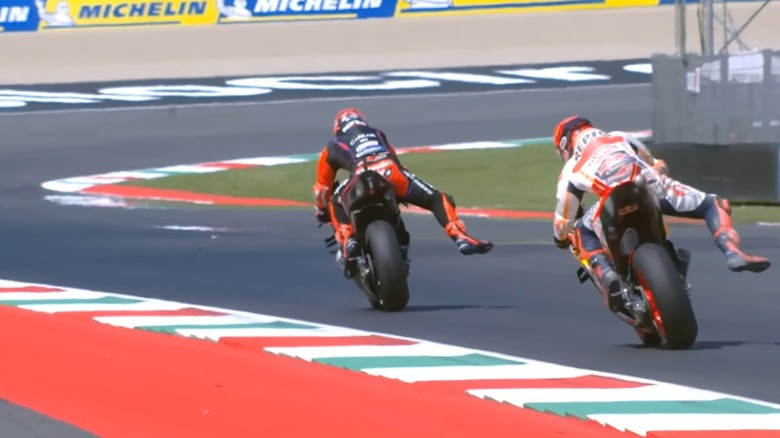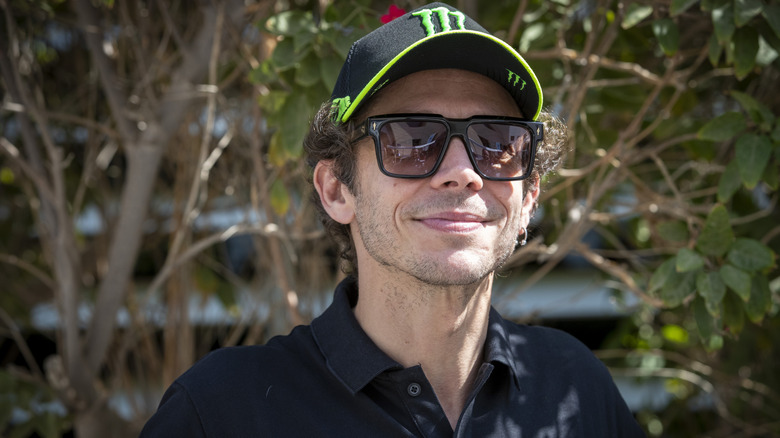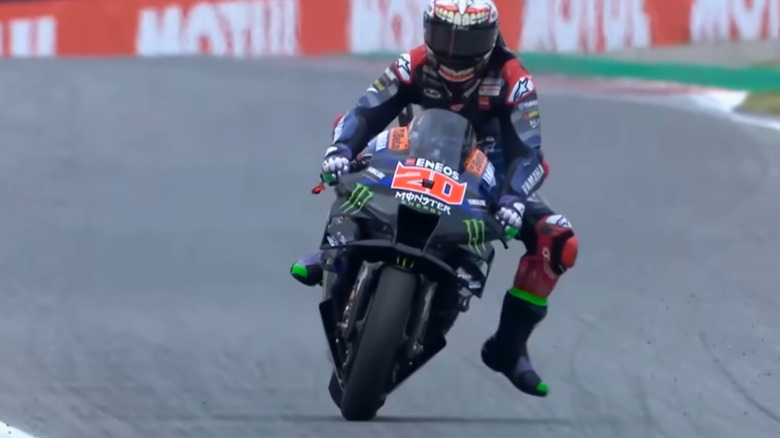Why Do MotoGP Riders Stick Their Leg Out?
MotoGP is an incredibly fast and dangerous competitive sport that captures the attention of curious onlookers and enthusiasts alike. With 1000cc four-strokes, such as the near-300 horsepower engine Yamaha uses in MotoGP, these highly modified motorcycles can go from 0 to 60 miles per hour in under 3 seconds, and reach speeds in excess of 220 miles per hour. While many of the major motorcycle manufacturers are involved, some, like Kawasaki, don't race in MotoGP anymore.
It isn't just the speed, or the sheer power of these machines that make the racing events exciting, it's the fact that mere fractions of a second can determine who achieves a podium finish and who takes a loss. In an effort to shave precious milliseconds off their lap times, MotoGP riders experiment with different strategies such as body position, drifting, and even sticking their leg out while cornering. With regard to the latter, there are several theories as to why riders prop out their leg during a turn and it has to do with increasing wind resistance, creating a barrier to prevent another rider from passing, and copycatting a prominent figure in the sport, Valentino Rossi.
Who started the leg out maneuver?
Valentino Rossi is considered by many to be one of the all-time MotoGP greats, who has racked up an impressive nine world titles. In fact, due to his masterful and precise talent on the track, he earned the nickname "The Doctor," and is respected by his rivals and admired by fans. He also is famous for sporting one of the most iconic motorcycle liveries of all time.
During a race in 2005, Rossi was nearing the end, when he quickly found himself about to crash into another rider navigating the final bend. As if by instinct alone, Rossi stuck his leg out in a move that hadn't been seen in the sport prior, and was able to overtake his opponent and achieve victory. This unusual move got a lot of attention and became know by many names, such as the "Doctor Dangle."
As you might imagine, when a legend like Rossi performs a new maneuver and takes the podium, not only will younger riders copy it, but competitors might start experimenting with it themselves. After all, it could've been responsible for Rossi's win, and might provide some sort of competitive advantage. Since 2005, riders have been sticking their leg out while cornering, even after Rossi divulged, he does it because it feels natural, but couldn't elaborate anymore on the subject.
What makes the leg out move effective?
While the man who started the move may not have answers as to why sticking your leg out on a corner is a good technique, there are plenty of theories. One of the advantages of setting your leg outward is that it provides more wind resistance. It's the same reason why a rider may sit up prior to a turn, essentially using their body and the added force against it from the wind, as a means to improve braking force.
Another reason riders may poke their leg out, is to stop competitors from overtaking their position and surging past them on the track. In terms of passing an opponent, the most advantageous time is when they are applying the brake and navigating a turn. Racers will often take this opportunity to utilize the inside track of a corner and slip past rivals, gaining a position in the process. With a leg directly in the way of an inside overtake route, it becomes more challenging to pass. Although, this could be partly responsible for the dangerous maneuvers that lead to MotoGP disasters.


